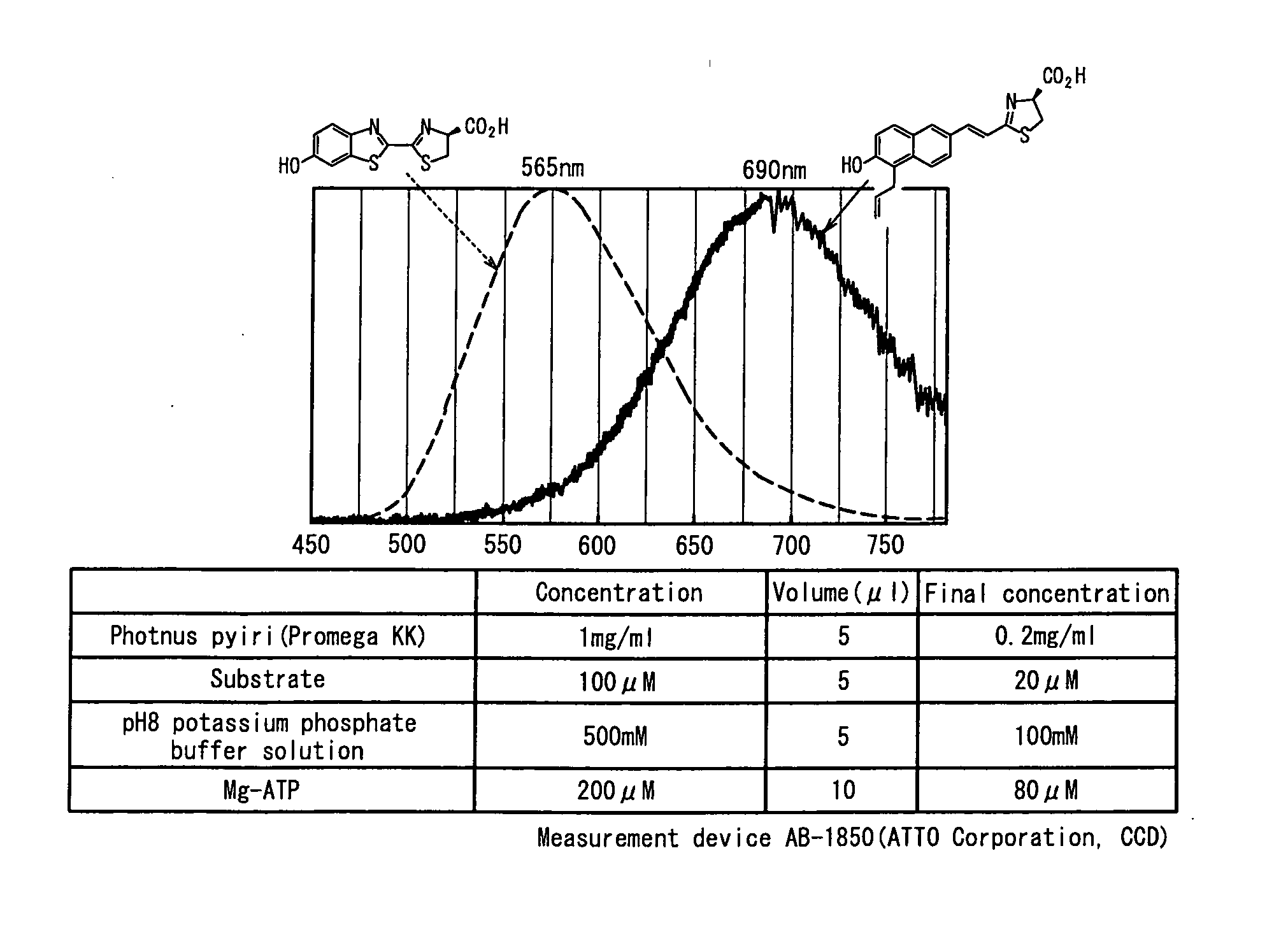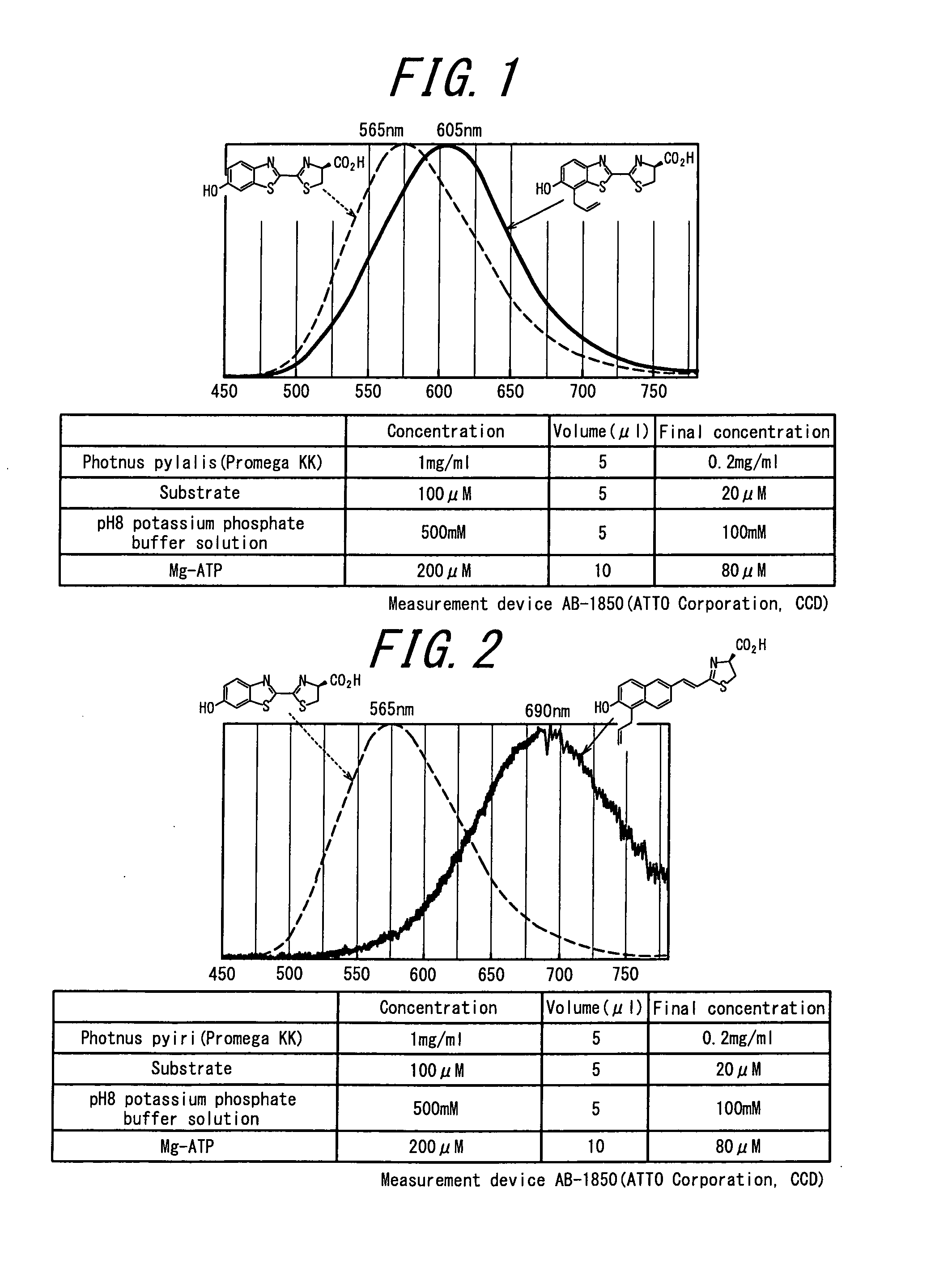Luminescent substrate for luciferase
- Summary
- Abstract
- Description
- Claims
- Application Information
AI Technical Summary
Benefits of technology
Problems solved by technology
Method used
Image
Examples
example 1
Synthesis of 7-Allyl-Firefly Luciferin
[0131]7-allyl-firefly luciferin was synthesized in accordance with the following synthesis scheme.
Synthesis of 2-Cyano-6-Hydroxybenzothiazole 32
[0132]
[0133]Pyridine hydrochloride (2.32 g) was added to 2-cyano-6-methoxybenzothiazole 31 (51.4 mg, 0.271 mmol) and heated to 200° C. in an argon atmosphere to dissolve the pyridine hydrochloride, and the reaction mixture was stirred for 30 minutes. The reaction mixture was allowed to cool, and then 1 M hydrochloric acid (50 ml) was added. After extraction with ethyl acetate (3×50 ml) and drying of the organic layer with anhydrous sodium sulfate, the result was concentrated in vacuo. The resulting residue was purified by preparative thin-layer silica gel chromatography {one 20 cm×20 cm×1.75 mm plate; hexane-ethyl acetate (1:1)}, yielding 2-cyano-6-hydroxybenzothiazole 32 (47.2 mg, 99%) as a pale yellow solid.
[0134]1H NMR (270 MHz, CD3OD) δ 7.17 (1H, dd, J=2.7, 9.2 Hz), 7.41 (1H, d, J=2.7 Hz), 7.99 (1H, ...
example 2
[0144]a compound modified by an allyl group at the 5-Position of the naphthol moiety was synthesized.
[0145]The following compound:
was synthesized in accordance with the following synthesis scheme.
[0146]2-naphthoic acid 11 (500 mg, 2.66 mmol) was dissolved in acetone (10 ml), potassium carbonate (793 mg, 5.32 mmol) and allyl bromide (0.7 ml, 8.0 mmol) were added under ice cooling, and the reaction solution was stirred at room temperature for 1 hour. Water (100 ml) was added to the reaction solution, and after extraction with ethyl acetate, the organic layer was dehydrated with anhydrous magnesium sulfate. The solvent was distilled under reduced pressure, and the resulting crude product was purified by silica gel column chromatography (hexane:ethyl acetate=5:1), yielding compound 12 (713 mg, 100%) as a light yellow solid.
[0147]1H NMR (400 MHz, CDCl3) δ 4.67 (2H, d, J=4.8 Hz), 5.33 (2H, t, J=10.8 Hz), 5.46 (2H, m), 6.11 (2H, m), 7.16 (1H, d, J=2.4 Hz), 7.22 (1H, dd, J=2.4, 8.8 Hz), 7.7...
reference example 3
Synthesis of Naphthol-Monoene Type Luciferin Analog
Synthesis of TBS Protector 32
[0162]
[0163]6-cyano-2-naphthol 31 (50.2 mg, 0.297 mmol), t-butyldimethylsilyl chloride (143 mg, 0.95 mmol), and imidazole (160.7 mg, 2.37 mmol) were dissolved in DMF (0.5 mL), and the reaction mixture was stirred at room temperature for 1 hour. Water (40 mL) was added to the reaction mixture, and extraction was performed with ethyl acetate (3×60 mL). After drying the organic layer with sodium sulfate, the result was concentrated in vacuo. The resulting residue was purified by column chromatography {silica gel 36 g; hexane-ethyl acetate (8:1)}, yielding a TBS protector 32 (69.9 mg, 83%) as a colorless oil.
[0164]Analog 32
[0165]1H NMR (270 MHz, CDCl3) δ 0.01 (6H, s), 0.74 (9H, s), 6.80-7.80 (6H, complex)
Synthesis of Aldehyde Product 33
[0166]
[0167]TBS protector 32 (99.3 mg, 0.35 mmol) and 1 M diisobutylaluminium (toluene solution) 0.5 mL were dissolved in dehydrated toluene (10 mL) in an argon atmosphere, an...
PUM
 Login to View More
Login to View More Abstract
Description
Claims
Application Information
 Login to View More
Login to View More - R&D
- Intellectual Property
- Life Sciences
- Materials
- Tech Scout
- Unparalleled Data Quality
- Higher Quality Content
- 60% Fewer Hallucinations
Browse by: Latest US Patents, China's latest patents, Technical Efficacy Thesaurus, Application Domain, Technology Topic, Popular Technical Reports.
© 2025 PatSnap. All rights reserved.Legal|Privacy policy|Modern Slavery Act Transparency Statement|Sitemap|About US| Contact US: help@patsnap.com



